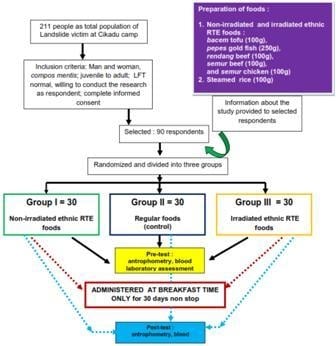Potential Use of Gamma-Irradiated Ethnic Ready-to-Eat Foods to Improve the Nutritional Status of Landslide Victims
Abstract
:1. Introduction
2. Materials and Methods
2.1. Materials
2.2. Methods
2.3. Quality Assessments
3. Results
4. Discussion
5. Techno-Economy Feasibility
5.1. Cost Benefit Approach to Irradiate Ethnic Ready-to-Eat Foods in a Commercial Irradiator
- a.
- Irradiation of ethnic RTE foods at a medium dose (8–10 kGy)
- b.
- Irradiation of ethnic RTE foods at high dose (Min. 45 kGy)
6. Conclusions and Recommendation
Acknowledgments
Conflicts of Interest
References
- Anonymous. Regulation of irradiation; No. 701/MENKES/PER/VIII/2009; The Republic of Indonesia, Decree of Ministry of Health the Republic of Indonesia: Jakarta, Indonesia, 2009. [Google Scholar]
- Placek, V.; Svobodova, V.; Bartoni, B.; Rosmus, J.; Amra, M. Shelf-stable food through high dose irradiation. Radiat. Phys. Chem. 2004, 71, 515–518. [Google Scholar] [CrossRef]
- Ahmad, A.; Khan, M. Shelf-life extension of a common Asian ready to eat meal (alu-qeena) by gamma irradiation and improve package. Adv. Food Sci. 2008, 30, 181–184. [Google Scholar]
- Chilled Food Association. Shelf Life of Ready to Eat Food in Relation to Listeria Monocytogenes—Guidance for Food Business Operator, 1st ed.; Chilled Food Association LTD: Kettering, UK, 2010. [Google Scholar]
- Anonymous. Putting the Pieces Together—A Companion Guide to Improving Nutrition and Food Safety for Persons Living With HIV/AIDS; 2-1-1 Big Bend, Inc.: Tallahassee, FL, USA, 2002. [Google Scholar]
- Narvaiz, P.; Gimenez, P.; Horak, E.; Pietranera, M.A.; Kairiyama, E.; Gronostajski, D.; Ribetto, A.M. Feasibility of obtaining safe, shelf-stable, nutritive and more varied whole rations of immuno-suppressed patients by gamma irradiation. In Proceedings of a Final Research Coordination Meeting Held in Montreal, QC, Canada, 10–14 July 2000; International Atomic Energy Agency: Vienna, Austria, 2003; pp. 62–84. [Google Scholar]
- Irawati, Z.; Pertiwi, Z.K.; dan Zakaria, F.R. Uji toksisitasterhadap kadar malondialdehida dan kapasitas antioksidan pada rendang steril iradiasi: In vitro. Jurnal Ilmiah Aplikasi Isotopdan Radiasi 2010, 6, 31. (In Indonesian) [Google Scholar]
- Irawati, Z.; Putri, K.R.; dan Zakaria, F.R. Aspek keamanan pangan: Uji Toksisitas Secara in vitro Pepes Ikan Mas (Cyprinuscarpio) yang Disterilkan Dengan Iradiasi Gamma. Jurnal Ilmiah Aplikasi Isotopdan Radiasi 2011, 7, 9. (In Indonesian) [Google Scholar]
- Irawati, Z.; Sani, Y. Feeding studies of radiation sterilization ready to eat foods on Sprague dawley rats: In vivo. Nat. Sci. J. 2012, 4, 116. [Google Scholar]
- International Atomic Energy Agency. Use of Irradiation for Shelf-Stable Sterile Foods for Immuno-Compromised Patients and Other Specific Target Groups. Report of the Consultant Meeting, International Atomic Energy Agency, Vienna, Austria, 24–27 November 2009; Working Material Reproduced by the IAEA: Vienna, Austria, 2010. [Google Scholar]
- Henon, Y. Food Made Safe by Irradiation Feeds Landslide Victims in Indonesia, IAEA Division of Nuclear techniques in Food and Agriculture. Available online: www.iaea.org/newscenter/news/2014/food-made-safe.html (accessed on 1 November 2015).
- International Atomic Energy Agency. Radiation processing for safe, shelf-stable and ready to eat food. In Proceedings of a Final Research Coordination Meeting Held in Montreal, QC, Canada, 10–14 July 2000; International Atomic Energy Agency: Vienna, Austria, 2003. [Google Scholar]
- IAEA. Shelf-Stable Foods through Irradiation Processing; Report prepared by the Food Preservation Section, Joint FAO/IAEA Division of Nuclear Techniques in Food and Agriculture; International Atomic Energy Agency: Vienna, Austria, 1995. [Google Scholar]
- Irawati, Z.; Natalia, N.; Nurcahya, C.M.; Anas, F.; Tampubolon, M. Irradiation for the safety and quality of home style frozen snacks. J. Atom Indones. 2005, 31, 1–12. [Google Scholar] [CrossRef]
- Irawati, Z.; Natalia, N.; Nurcahya, C.M.; Anas, F. The role of medium radiation dose on microbiological safety and shelf-life of some traditional soups. Radiat. Phys. Chem. 2007, 76, 1847–1854. [Google Scholar] [CrossRef]
- Irawati, Z.; Nurcahya, C.M.; Lubis, I. Irradiation to ensure the safety and shelf-life extension of traditional ready to eat meals: Aremarem. In Proceedings of the International Conference on Investing in Food Quality, Safety & Nutrition, Lessons Learned from Current Food Crisis, Organized by Seafast Center and the Borlaug Institute, Jakarta, Indonesia, 27–28 October 2008; SEAFAST Center, Bogor Agricultural: Jakarta, Indonesia, 2009; pp. 265–275. [Google Scholar]
- Durnin, J.V.G.A.; Womersley, J. Body fat assessed from total body density and its estimation from skinfold thinkness: Measurements on 481 men and women aged from 16 to 72 Years. Br. J. Nutr. 1974, 32, 77–97. [Google Scholar] [CrossRef] [PubMed]
- Simanungkalit, B.; Irawati, Z.; Siagian, C.M.; dan Widasari, L. Studi Intervensi Pangan Olahan Siap Saji Steril Iradiasi pada Residen Rehabilitasi Narkoba. Jurnal Ilmiah Aplikasi Isotop dan Radiasi 2013, 9, 35–44. (In Indonesian) [Google Scholar]
- Siagian, C.M.; Irawati, Z.; Simanungkalit, B. An Intervention Study Using Irradiated Ethnic Ready to Eat Foods in Immunocompromised Patients; BATAN: Jakarta, Indonesia, 2012. [Google Scholar]
- Harsono, I.K. Karakterisasi Protein pada Rendang Sapi Steril Iradiasidengan Aplikasi Nanoteknologi, Karakterisasi Protein pada Rendang Sapi Steril Iradiasi Dengan Aplikasi Nanoteknologi; Fakultas Farmasi, Universitas Pancasila: Jakarta, Indonesia, 2015. (In Indonesian) [Google Scholar]
- Immanuel, G.L. Pengaruh Iradiasidan Aplikasi Nanoteknologiterhadap Aktivitas Antioksidandan Matriks Non Protein Rendang Sapi Steril Iradiasi; Fakultas Farmasi, Universitas Pancasila: Jakarta, Indonesia, 2015. (In Indonesian) [Google Scholar]
- De Bruyn, I. Prospects of radiation sterilization of shelf-stable food. In Irradiation for Food Safety and Quality, Proceedings of the FAO/IAEA/WHO International Conference on Ensuring the Safety and Quality of Food through Radiation Processing, Antalya, Turkey, 2000; Loaharanu, P., Thomas, P., Eds.; Technomic Publishing Co. Inc.: Lancaster, PA, USA, 2001. [Google Scholar]
- Chen, J.; Li, W.; Huang, X.; Guo, C.; Zou, R.; Yang, Q.; Zhang, H.; Zhang, T.; Chen, H.; Wu, H. Evaluating total lymphocyte count as a surrogate marker for CD4 cell count in the management of HIV-infected patients in resource-limited settings: A study from China. PloS ONE 2013, 8, e69704. [Google Scholar] [CrossRef] [PubMed]
- Siagian, C.M.; Irawati, Z.; Simanungkalit, B.; Woodside, J. An intervention study using irradiated ethnic ready to eat foods in immunocompromised patients. Pakistan J. Nutr. 2015, 14, 461–467. [Google Scholar] [CrossRef]
- Siagian, C.M.; Simanungkalit, B.; Nurcahya, C.M.; Nilatany, A.; Lasmawati, D.; Pratama, I.M.; Irawati, Z. Potential use of gamma irradiated ethnic meal ready to eat foods to improve nutritional status of school children. IJSBAR 2015, 24, 200–209. [Google Scholar]
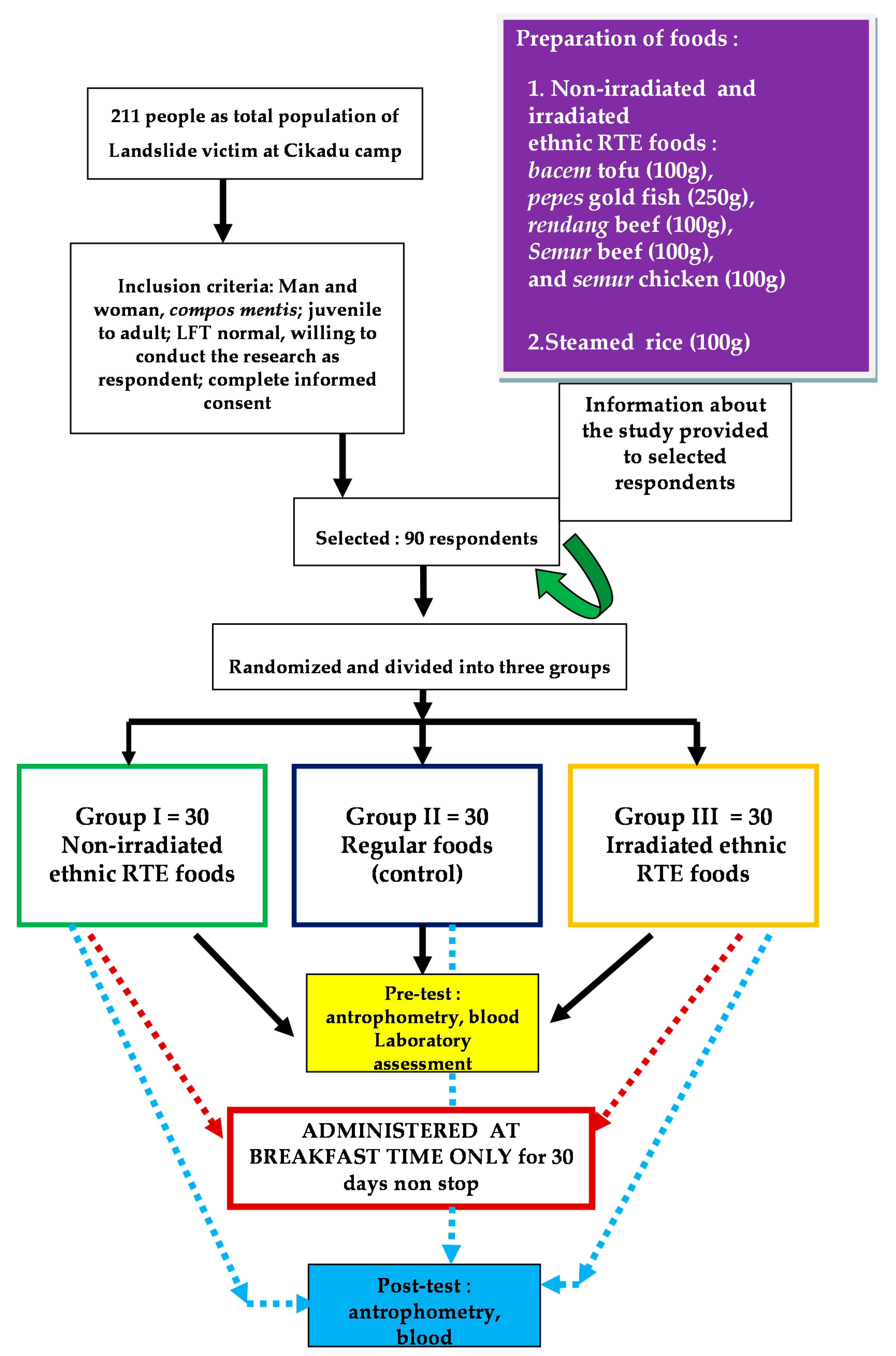
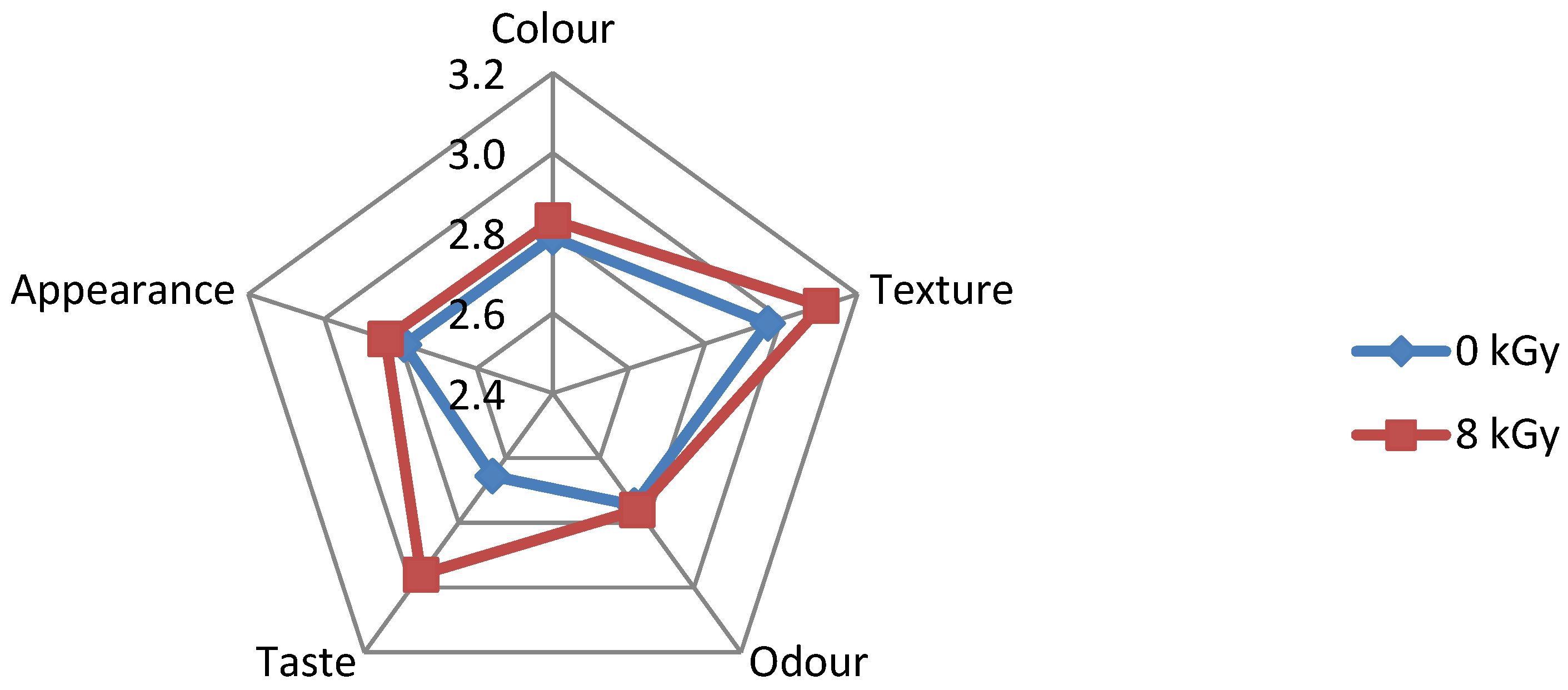
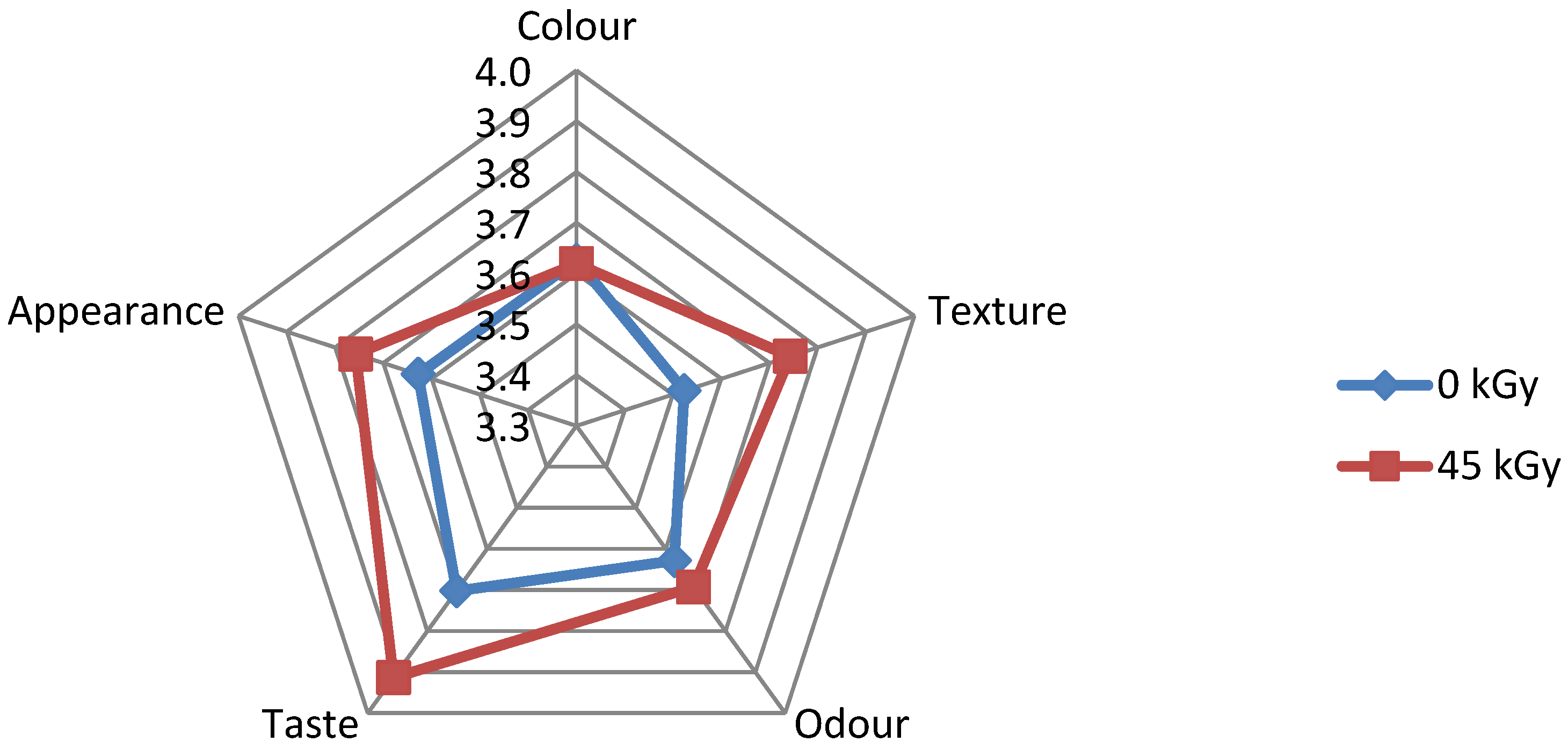
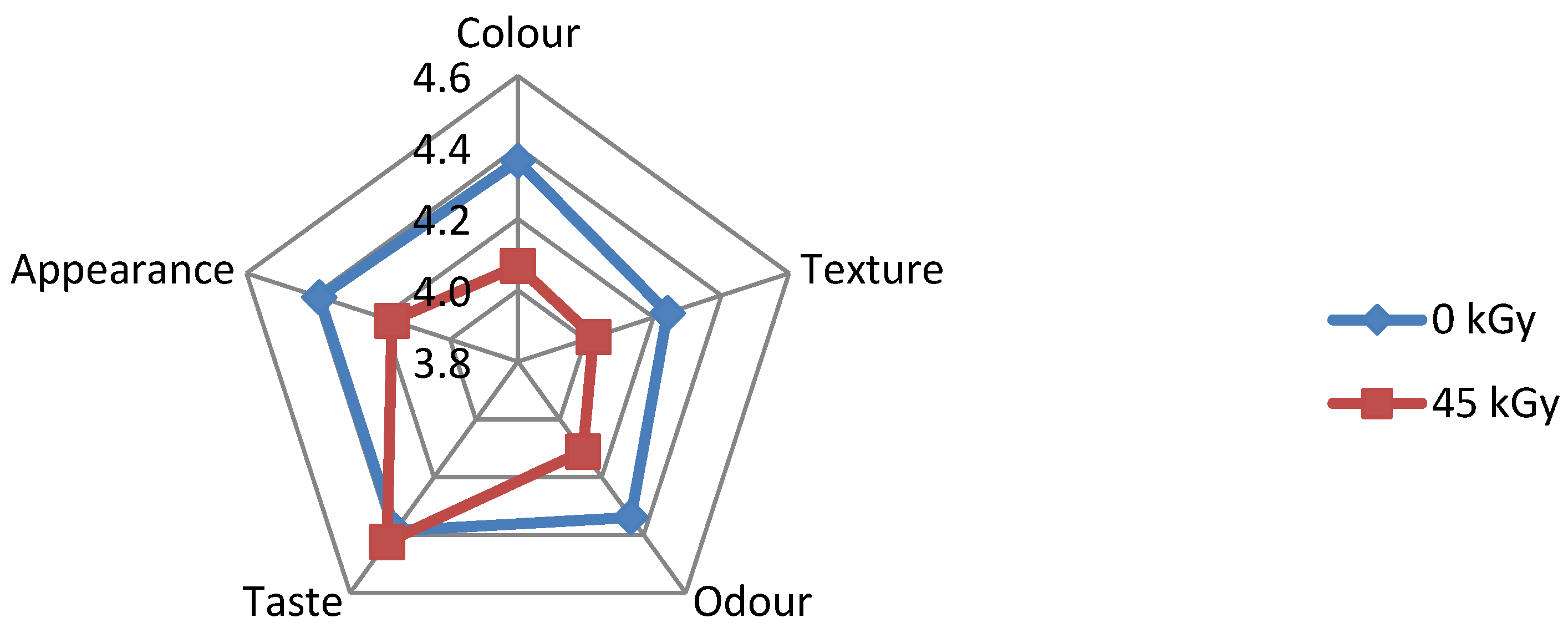
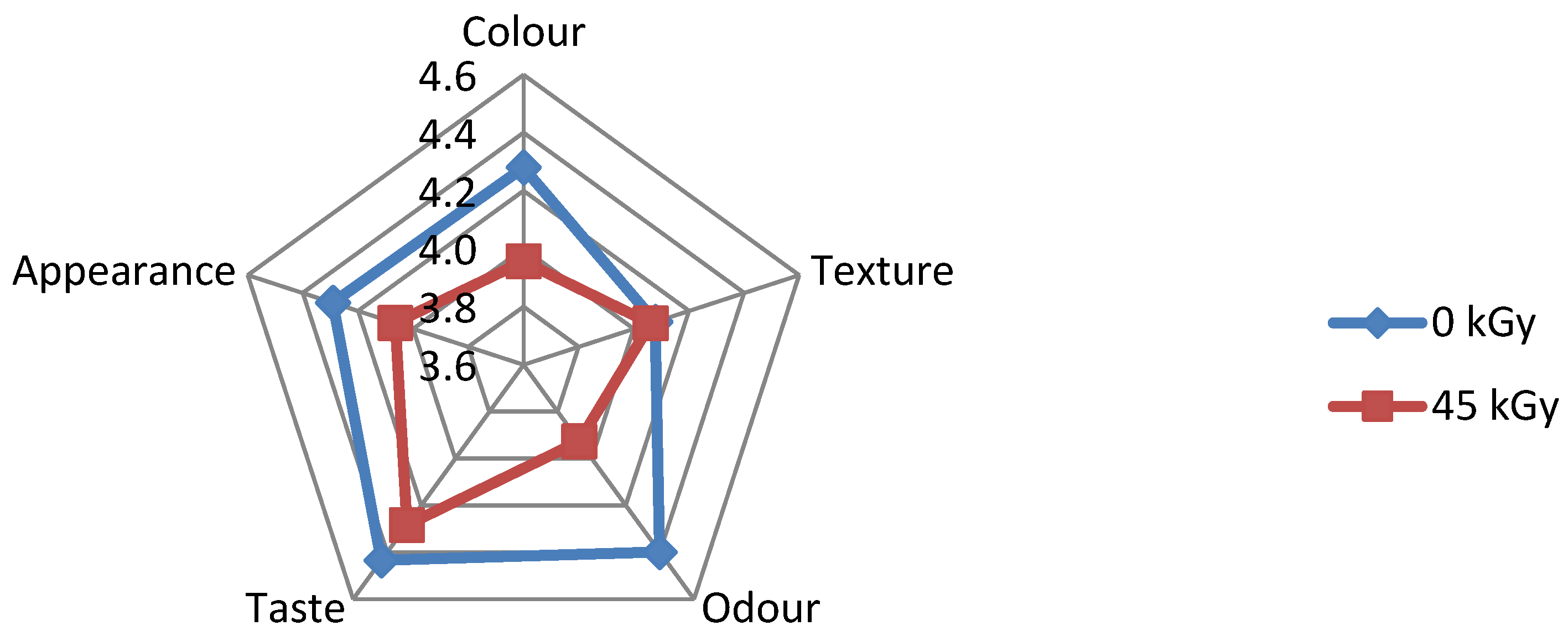
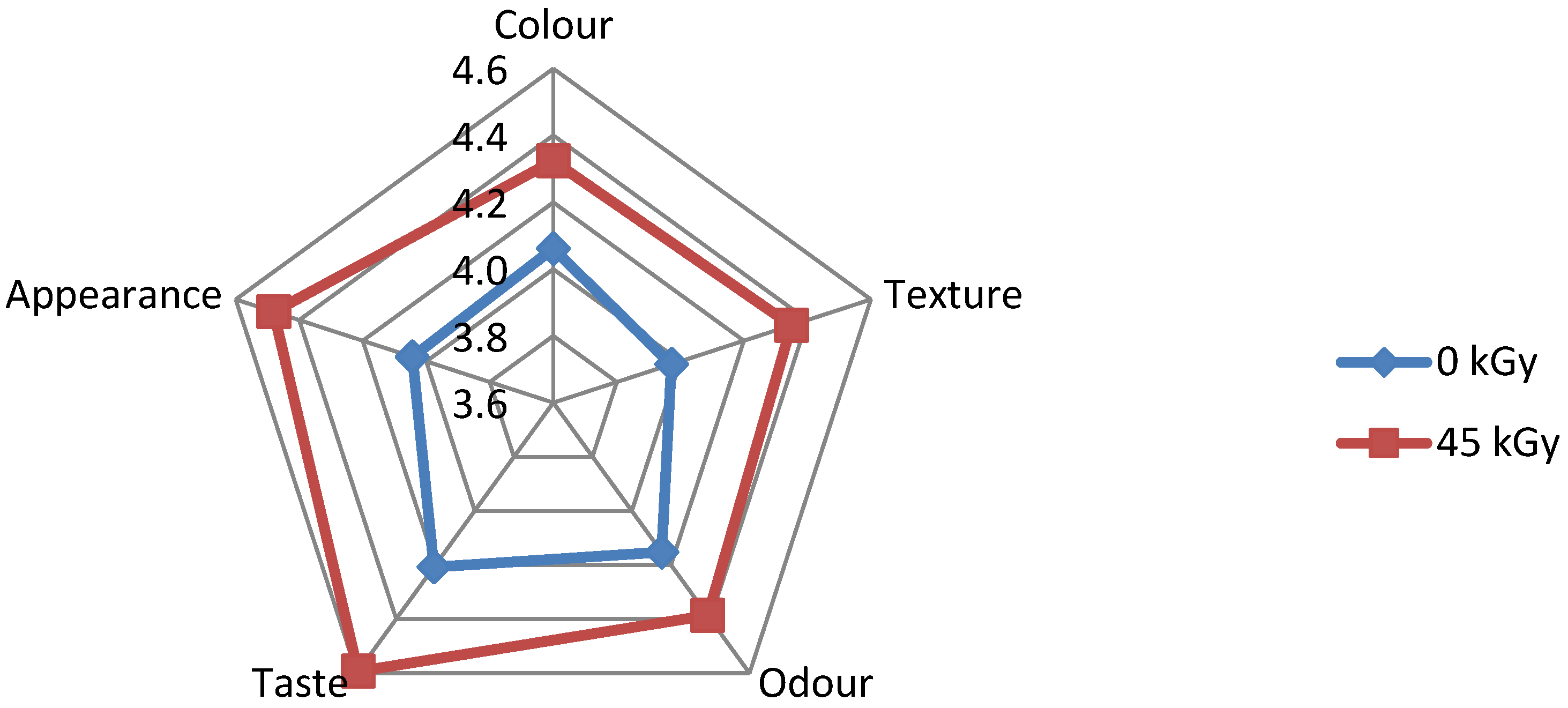
| Day | Menu |
|---|---|
| 1st 2nd 3rd 4th 5th | Rice and rendang beef Rice and bacem tofu Rice and semur beef Rice and pepes gold fish Rice and semur chicken |
| Parameter | Group I * (n = 30) | Group II ** (n = 30) | Group III *** (n = 30) |
|---|---|---|---|
| BMI (kg/m2) pre test | 23.22 ± 3.82 | 23.13 ± 3.94 | 23.03 ± 4.39 |
| BMI (kg/m2) post test | 23.33 ± 3.90 | 23.03 ± 3.88 | 22.96 ± 4.36 |
| Biceps (mm) pre test | 1.86 ± 0.58 | 2.37 ± 0.82 | 2.73 ± 1.20 |
| Biceps (mm) post test | 3.94 ± 1.71 | 3.59 ± 1.38 | 4.04 ± 2.18 |
| Albumin (g/dL) pre test | 4.26 ± 0.32 | 4.43 ± 0.30 | 4.37 ± 0.23 |
| Albumin (g/dL) post test | 4.23 ± 0.32 | 4.26 ± 0.32 | 4.45 ± 0.32 |
| Hemoglobin (g/dL) pre test | 13.66 ± 1.82 | 14.03 ± 2.22 | 14.38 ± 1.25 |
| Hemoglobin (g/dL) post test | 13.35 ± 1.88 | 13.67 ± 2.08 | 14.14 ± 1.33 |
| Total lymphocyte counts (%) pre test | 34.00 ± 6.96 | 33.50 ± 7.5 | 33.58 ± 7.29 |
| Total lymphocyte counts (%) post test | 34.40 ± 7.89 | 34.01 ± 8.00 | 32.83 ± 8.40 |
© 2016 by the authors; licensee MDPI, Basel, Switzerland. This article is an open access article distributed under the terms and conditions of the Creative Commons Attribution (CC-BY) license (http://creativecommons.org/licenses/by/4.0/).
Share and Cite
Koenari, Z.I.; Siagian, C.M.; Simanungkalit, B.; Nilatany, A.; Pratama, I.M.; Lasmawati, D.; Nurcahya, C.M. Potential Use of Gamma-Irradiated Ethnic Ready-to-Eat Foods to Improve the Nutritional Status of Landslide Victims. Foods 2016, 5, 53. https://doi.org/10.3390/foods5030053
Koenari ZI, Siagian CM, Simanungkalit B, Nilatany A, Pratama IM, Lasmawati D, Nurcahya CM. Potential Use of Gamma-Irradiated Ethnic Ready-to-Eat Foods to Improve the Nutritional Status of Landslide Victims. Foods. 2016; 5(3):53. https://doi.org/10.3390/foods5030053
Chicago/Turabian StyleKoenari, Zubaidah Irawati, Carmen M. Siagian, Bona Simanungkalit, Asti Nilatany, Indra Mustika Pratama, Deudeu Lasmawati, and Cecep M. Nurcahya. 2016. "Potential Use of Gamma-Irradiated Ethnic Ready-to-Eat Foods to Improve the Nutritional Status of Landslide Victims" Foods 5, no. 3: 53. https://doi.org/10.3390/foods5030053
APA StyleKoenari, Z. I., Siagian, C. M., Simanungkalit, B., Nilatany, A., Pratama, I. M., Lasmawati, D., & Nurcahya, C. M. (2016). Potential Use of Gamma-Irradiated Ethnic Ready-to-Eat Foods to Improve the Nutritional Status of Landslide Victims. Foods, 5(3), 53. https://doi.org/10.3390/foods5030053





